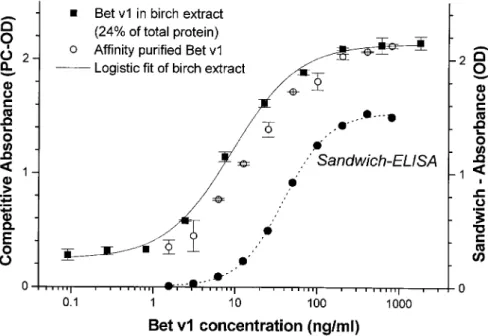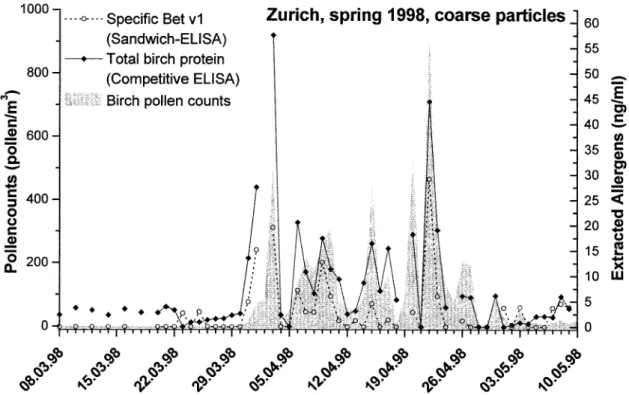Aerobiologia 16: 251–254, 2000.
© 2000 Kluwer Academic Publishers. Printed in the Netherlands. 251
Determination of birch pollen allergens in different aerosol sizes
Michael Riediker
∗, Theo Koller & Christian Monn
Institute for Hygiene and Applied Physiology, Environmental Hygiene Section, Swiss Federal Institute of Techno-logy, Zürich, Switzerland
(∗author for correspondence: r-mail: riediker@iha.bepr.ethz.ch; fax: +41 1 632 1173)
Received 15 October 1999; accepted in final form 15 February 2000
Key words: allergens, birch, determination, ELISA, fine particles, pollen
Abstract
Allergens in fine particles may cause symptoms in allergic asthmatics. In order to assess the exposure of susceptible persons, a method to measure the allergen load in fine and coarse particles was developed.
Aerosols are collected with a high-volume air sampler by multistage impaction. They are separated into five size classes, ranging from >10 µm to <1 µm and sampled on glass fibre filters. After sampling, filters are crushed into a fine powder using a hydraulic press. Allergens are then eluted on a shaker into Tween-20-containing phosphate buffered saline. After microfiltration, the eluate is ready for analysis with ELISA-techniques (Enzyme Linked Immuno Sorbens Assay).
Two different methods are used for the analysis of allergens: One is a sandwich-ELISA using monoclonal IgG-antibodies, the other is a competitive ELISA based on polyclonal IgE-antibodies obtained from patients allergic to birch pollen. Using the monoclonal antibodies information on the amount of one particular allergen (the major allergen Bet v1) is obtained. On the other hand the competitive ELISA using the polyclonal IgE is much more sensitive and indicates the total birch pollen allergens. Data obtained during spring 1998 show good correlation of pollen counts and allergen content in the coarse particle fraction containing intact pollen (>10 µm). In smaller sized fractions, the allergen load is often close to the detection limit. When clearly detectable amounts of allergen are present, in the fine size fraction the allergen load shows only a weak correlation to the pollen counts and the allergen concentrations in the coarse particle fraction.
Introduction
Exposure to pollen allergen loaded fine particles (< about 10 µm) is related to allergic airway response in pollen-sensitised asthmatics (Rosenberg, Rosenthal et al., 1983). Mainly particles smaller than 10 µm can penetrate into the lower parts of the airways (Schlesinger, 1985).
In order to assess the exposure of susceptible persons, a method was developed to measure the allergen load in fine and coarse particles containing very little or a large number of intact pollen, respec-tively.
Materials and methods
Aerosols were collected with a cascade impactor with rectangular slots mounted on a high-volume sampler (565 l/min, DIGITEL DH77, Digitel AG, Switzer-land). The sampler was positioned on a rooftop in central Zurich. The cut-points of the sampling stages as indicated by the supplier were 10.2 µm (stage 1), 4.2 µm (stage 2), 2.1 µm (stage 3) and 1.4 µm (stage 4) (Marple and Liu, 1974; Willeke, 1975). A backup filter after stage 4 collected all remaining particles. Stage 2 was coated with silicone grease and used as a trap to catch bounced and blown-off pollen from stage 1 to prevent contamination of lower stages with intact pollen. On all other stages, particles were collected on glass fibre filters.
252
Figure 1. Competitive ELISA: A dilution series of affinity purified Bet v1 was run together with a dilution series of birch extract (in equivalents
of Bet v1). For comparison, the standard curve of the sandwich-ELISA is shown.
Every day during the pollen season the sampler was started at 7:00 AM and run for 24 hours. After sampling filters were folded twice and stored in polypropylene bags (MIGROS, Switzerland) at −40 ◦C until extraction. For extraction a modified
pulverisation technique according to Jensen et al., 1989 was used. Filters were first crushed into a fine powder using a hydraulic press (3 times 5 tons). Aller-gens were then eluted over night on a shaker at 30◦C into phosphate buffered saline (pH = 7.4) containing Tween-20 (0.5%) and sodium azide (0.01%). After microfiltration (0.45 µm, celluloseacetate, Schleicher & Schuell, Germany), extracts were stored at−40◦C until analysis with ELISA-techniques.
Two different methods were used for the analysis of allergen concentrations: One is a sandwich-ELISA using monoclonal IgG-antibodies (Schäppi, Monn et al., 1996), the other is a newly developed version of the competitive ELISA (Crowther, 1995) based on polyclonal IgE-antibodies obtained from patients allergic to birch pollen and a standardised birch pollen extract. For the sandwich-ELISA concentrations of the major allergen Bet v1, and for the competitive ELISA equivalents of Bet v1 of total protein are obtained. Statistical analysis was performed using Systat 8.0. To account for the skewed distribution of pollen and allergen data, Spearman rank-order correlation coeffi-cients were calculated. This measure is a
nonpara-metric version of the Pearson correlation coefficient, based on the ranks of the data and is independent of the distribution of the underlying data.
Results
In a competitive ELISA, a dilution series of affinity purified Bet v1 was run together with a dilution series of standardised birch extract (Figure 1). Concentra-tions of the extract are indicated as equivalents of Bet v1. Figure 1 indicates, that most of the compe-titive signal can be attributed to Bet v1. Comparison with the sandwich-ELISA shows, that the competi-tive ELISA is about ten times more sensicompeti-tive than the sandwich-ELISA.
Figure 2 shows the results for the birch pollen season 1998 in the coarse particle fraction (>10.2 µm Pollen counts were obtained from MeteoSwiss (SMA) Zurich (Burkard trap). For the sandwich ELISA, concentrations of the major allergen Bet v1, and for the competitive ELISA total protein from the birch extract are shown. Both allergen tests and the pollen counts are correlated during the pollen season (r > 0.8, p < 0.0001). In smaller sized particles, the allergen load is often below or close to the detection limit, especially for the sandwich-ELISA). Figure 3 shows the time course of the fine particles for the
compe-253
Figure 2. Time-course plot of pollen at SMA Zurich and allergen concentrations in the first stage of the sampler (>10.2 µm).
254
titive ELISA. On days with detectable amounts of allergen load in fine particles (competitive ELISA) the load is only weakly correlated with the pollen counts (4.2µm to 2.2µm: r = 0.57, p < 0.05) and the allergen concentrations in the coarse particle fraction.
Discussion and conclusions
Using the monoclonal antibodies in the sandwich-ELISA, information on the amount of one particular allergen (the major allergen Bet v1) is obtained. On the other hand the competitive ELISA using the poly-clonal IgE is much more sensitive but not specific for one particular epitope.
Data obtained during spring 1998 show that on most days birch pollen counts parallels the birch allergen load in the particle fraction containing intact pollen (>10.2 µm). The correlation, however, is much poorer for particles of smaller size than intact pollen (<10.2 µm). Allergen concentrations in these stages are often close to detection limit. It therefore remains unclear whether this weaker correlation is due to limitations of the ELISA or due to differences in the distribution of allergens on particles smaller than pollen.
Acknowledgements
This study is part of a co-operative project with the Allergy Unit of the University Hospital Zurich (Prof. B. Wüthrich). We would like to acknowledge Aller-gopharma Joachim Ganzer KG, Reinbek, Germany for providing allergens and the antibodies for the sandwich-ELISA.
References
Crowther J.R.: 1995, ELISA: Theory and Practice. Human Press Inc., Totowa, NJ.
Jensen J., Poulsen L.K. et al.: 1989, Immunochemical estimations of allergenic activities from outdoor aero-allergens, collected by a high-volume air sampler. Allergy 44(1), 52–59.
Marple V.A. and Liu B.Y.H.: 1974, Characteristics of laminar jet impactors. Environmental Science and Technology 8(7), 648– 654.
Rosenberg G.L., Rosenthal R.R. et al.: 1983, Inhalation challenge with ragweed pollen in ragweed-sensitive asthmatics. Journal of
Allergy and Clinical Immunology 71(3), 302–310.
Schäppi G., Monn C. et al.: 1996, Direct determination of aller-gens in ambient aerosols: Methodological aspects. International
Archives of Allergy and Immunology 110, 364–370.
Schlesinger R.B.: 1985, Comparative deposition of inhaled aero-sols in experimental animals and humans: A review. Journal of
Toxicology and Environmental Health 15(2), 197–214.
Willeke K.: 1975, Performance of the slotted impactor. American

